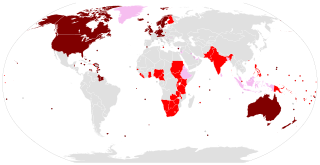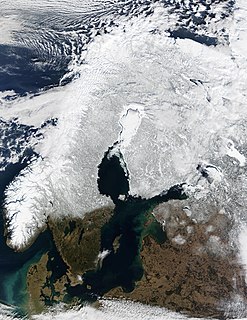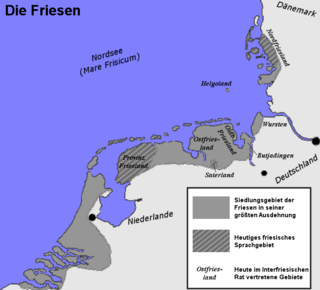
The Frisians are a Germanic ethnic group indigenous to the coastal parts of the Netherlands and northwestern Germany. They inhabit an area known as Frisia and are concentrated in the Dutch provinces of Friesland and Groningen and, in Germany, East Frisia and North Frisia. The Frisian languages are still spoken by more than 500,000 people; West Frisian is officially recognised in the Netherlands, and North Frisian and Saterland Frisian are recognised as regional languages in Germany.
Old English literature or Anglo-Saxon literature, encompasses literature written in Old English, in Anglo-Saxon England from the 7th century to the decades after the Norman Conquest of 1066. "Cædmon's Hymn", composed in the 7th century, according to Bede, is often considered the oldest extant poem in English, whereas the later poem, The Grave is one of the final poems written in Old English, and presents a transitional text between Old and Middle English. The Peterborough Chronicle can also be considered a late-period text, continuing into the 12th century.
Old English, or Anglo-Saxon, is the earliest historical form of the English language, spoken in England and southern and eastern Scotland in the early Middle Ages. It was brought to Great Britain by Anglo-Saxon settlers probably in the mid-5th century, and the first Old English literary works date from the mid-7th century. After the Norman conquest of 1066, English was replaced, for a time, as the language of the upper classes by Anglo-Norman, a relative of French. This is regarded as marking the end of the Old English era, as during this period the English language was heavily influenced by Anglo-Norman, developing into a phase known now as Middle English.
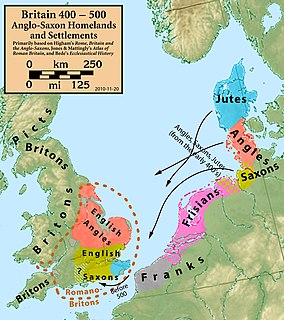
The Saxons were a Germanic people whose name was given in the early Middle Ages to a large country near the North Sea coast of what is now Germany. Earlier, in the late Roman Empire, the name was used to refer to Germanic inhabitants of what is now England, and also as a word something like the later "Viking", as a term for raiders. In Merovingian times, continental Saxons were associated with the coast of what later became Normandy. Though sometimes described as also fighting inland, coming in conflict with the Franks and Thuringians, no clear homeland can be defined. There is possibly a single classical reference to a smaller homeland of an early Saxon tribe, but it is disputed. According to this proposal, the Saxons' earliest area of settlement is believed to have been Northern Albingia. This general area is close to the probable homeland of the Angles.
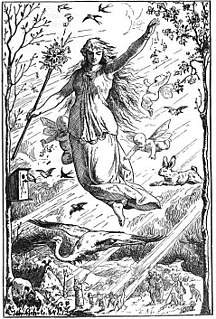
Ēostre or Ostara is a Germanic goddess who, by way of the Germanic month bearing her name, is the namesake of the festival of Easter in some languages. Ēostre is attested solely by Bede in his 8th-century work The Reckoning of Time, where Bede states that during Ēosturmōnaþ, pagan Anglo-Saxons had held feasts in Ēostre's honour, but that this tradition had died out by his time, replaced by the Christian Paschal month, a celebration of the resurrection of Jesus.
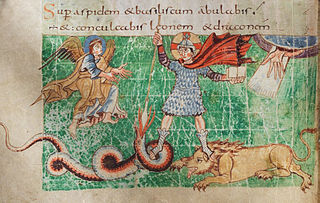
The Germanic peoples underwent gradual Christianization in the course of late antiquity and the Early Middle Ages. By AD 700, England and Francia were officially Christian, and by 1100 Germanic paganism had also ceased to have political influence in Scandinavia.

Germanic paganism refers to the indigenous religion of the Germanic people from the Iron Age until Christianisation during the Middle Ages. Rooted in Proto-Indo-European religion, Proto-Germanic religion expanded during the Migration Period, yielding extensions such as Old Norse religion among the North Germanic peoples, Continental Germanic paganism among the continental Germanic peoples, and Anglo-Saxon paganism among the West Germanic people. Among the East Germanic peoples, traces of Gothic paganism may be discerned from scant artifacts and attestations. According to John Thor Ewing, as a religion it consisted of "individual worshippers, family traditions and regional cults within a broadly consistent framework".
Anglo-Saxon law is a body of written rules and customs that were in place during the Anglo-Saxon period in England, before the Norman conquest. This body of law, along with early Scandinavian law and Germanic law, descended from a family of ancient Germanic custom and legal thought. However, Anglo-Saxon law codes are distinct from other early Germanic legal statements – known as the leges barbarorum, in part because they were written in Anglo-Saxon instead of in Latin. The laws of the Anglo-Saxons were the second in medieval Western Europe after those of the Irish to be expressed in a language other than Latin.
ᛈ is the rune denoting the sound p in the Elder Futhark runic alphabet. It does not appear in the Younger Futhark. It is named peorð in the Anglo-Saxon rune-poem and glossed enigmatically as follows:

The Elder Futhark, Elder Fuþark, Older Futhark, Old Futhark or Germanic Futhark is the oldest form of the runic alphabets. It was a writing system used by Germanic tribes for Northwest Germanic dialects in the Migration Period, the dates of which are debated among scholars. Runic inscriptions are found on artifacts, including jewelry, amulets, tools, weapons, and, famously, runestones, from the 2nd to the 8th centuries.
The rune ᚦ is called Thurs in the Icelandic and Norwegian rune poems. In the Anglo-Saxon rune poem it is called thorn, whence the name of the letter þ derived. It is transliterated as þ, and has the sound value of a voiceless dental fricative.

Migration Period art denotes the artwork of the Germanic peoples during the Migration period. It includes the Migration art of the Germanic tribes on the continent, as well the start of the Insular art or Hiberno-Saxon art of the Anglo-Saxon and Celtic fusion in the British Isles. It covers many different styles of art including the polychrome style and the animal style. After Christianization, Migration Period art developed into various schools of Early Medieval art in Western Europe which are normally classified by region, such as Anglo-Saxon art and Carolingian art, before the continent-wide styles of Romanesque art and finally Gothic art developed.

Anglo-Saxon England was early medieval England, existing from the 5th to the 11th centuries from the end of Roman Britain until the Norman conquest in 1066. It consisted of various Anglo-Saxon kingdoms until 927 when it was united as the Kingdom of England by King Æthelstan. It became part of the short-lived North Sea Empire of Cnut the Great, a personal union between England, Denmark and Norway in the 11th century.

The Anglo-Frisian languages are the West Germanic languages which include Anglic and Frisian.
Continental Germanic mythology is a subtype of Germanic paganism as practiced in parts of Central Europe during the 6th to 8th centuries, a period of Christianization. It continued in the legends, and Middle High German epics of the Middle Ages. Traces of these stories, with the sacred elements largely removed, may be found throughout European folklore and fairy tales.

The spear or lance, together with the bow, the sword, the seax and the shield, was the main equipment of the Germanic warriors during the Migration Period and the Early Middle Ages.
Germanic given names are traditionally dithematic; that is, they are formed from two elements, by joining a prefix and a suffix. For example, King Æþelred's name was derived from æþele, for "noble", and ræd, for "counsel".

Annepont is a commune in the Charente-Maritime department in the Nouvelle-Aquitaine region of southwestern France.
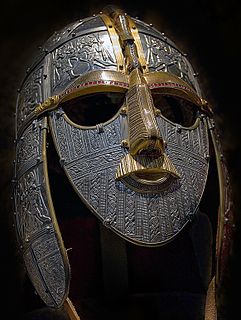
The Anglo-Saxon settlement of Britain describes the process which changed the language and culture of most of what became England from Romano-British to Germanic. The Germanic-speakers in Britain, themselves of diverse origins, eventually developed a common cultural identity as Anglo-Saxons. This process occurred from the mid-fifth to early seventh centuries, following the end of Roman rule in Britain around the year 410. The settlement was followed by the establishment of Anglo-Saxon kingdoms in the south and east of Britain, later followed by the rest of modern England.
Ceatta of Lichfield is an obscure Anglo Saxon saint of the Catholic Church.
